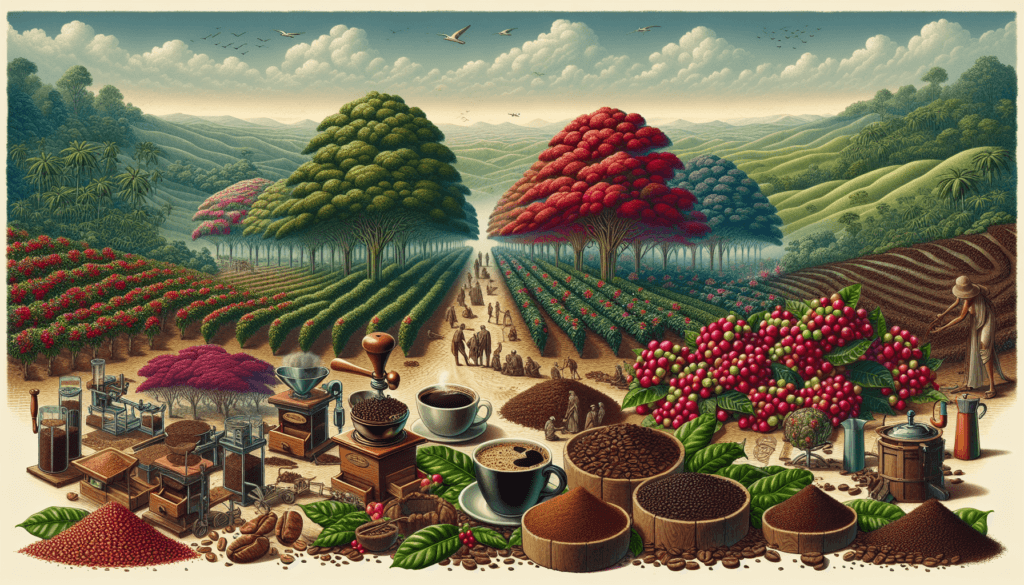Have you ever wondered which plant gives us the delightful beverage that we all know and love as coffee? The answer may surprise you. Coffee, that aromatic and energizing elixir, comes from the humble coffee plant. Yes, it’s true! This captivating article will take you on a journey to discover the origins of our favorite morning pick-me-up. So grab a cup of joe, sit back, and let’s explore which amazing plant cultivates the beans that bring us so much joy.

History of Coffee
Origin of Coffee
Coffee, one of the world’s most beloved beverages, has a rich and fascinating history that dates back centuries. The exact origin of coffee is believed to be in Ethiopia, where the coffee plant was first discovered. According to legend, a goat herder named Kaldi noticed that his goats became energized after consuming the berries from a certain plant. Intrigued, he decided to try the berries himself and experienced a similar invigorating effect. This discovery eventually led to the cultivation and widespread consumption of coffee.
Spread of Coffee Cultivation
From Ethiopia, coffee cultivation spread to the Arabian Peninsula in the 15th century. The Arabians were the first to actively cultivate coffee plants and were responsible for introducing the practice of brewing coffee. Coffee quickly became popular in Arabia, particularly in the city of Mocha (from which the term “mocha” coffee originated). The Arabian port of Mocha actually became a significant trading hub for coffee, with beans being exported to other parts of the world.
Introduction of Coffee to Different Countries
Coffee was introduced to different countries in various ways. In the 17th century, coffee made its way to Europe through trade routes, and it quickly gained popularity among European elites. Coffeehouses began to spring up in cities like London, Paris, and Vienna, becoming centers of intellectual and social activity. Meanwhile, Dutch traders brought coffee to their colonies in Southeast Asia, leading to the establishment of coffee plantations in places like Java and Sumatra.
Coffee Plant Species
Arabica Coffee
Arabica coffee, scientifically known as Coffea arabica, is the most widely consumed coffee species. It is prized for its delicate flavor and aroma, making it the preferred choice for specialty coffees. Arabica plants grow at higher altitudes and require specific conditions to thrive. They are more susceptible to diseases and pests, making cultivation more challenging but ultimately resulting in a superior quality coffee bean.
Robusta Coffee
Robusta coffee, scientifically known as Coffea canephora, is the second most commonly grown coffee species. Unlike Arabica, Robusta coffee is known for its stronger and more bitter taste. Robusta plants are hardier and can tolerate lower altitudes and varying climatic conditions. The beans produced from Robusta plants have a higher caffeine content, making them a popular choice for instant coffee and espresso blends.
Other Coffee Species
In addition to Arabica and Robusta, there are several other coffee species that are less commonly cultivated. These include Coffea liberica, which is primarily grown in West Africa, and Coffea excelsa, which is found in regions like the Philippines. While these species do not enjoy the same popularity as Arabica and Robusta, they contribute to the diverse range of coffee flavors and characteristics available in the market.

Growth Conditions
Climatic Requirements
Coffee plants thrive in tropical climates with temperatures ranging between 60°F and 70°F (15°C-24°C). They require a stable climate with no extreme temperature fluctuations. The ideal rainfall for coffee cultivation falls within the range of 60 inches to 100 inches (150-250 cm) annually. However, a well-distributed rainfall pattern is crucial, as excess moisture can lead to diseases and pests.
Altitude and Terrain
Altitude plays a significant role in the flavor profile of coffee. Typically, higher altitudes result in slower bean development and a more complex flavor. Arabica coffee thrives at altitudes ranging from 2,000 to 6,000 feet (600-1,800 meters) above sea level, while Robusta can tolerate lower altitudes of around 200 to 2,000 feet (60-600 meters). The terrain should ideally have slopes to facilitate good drainage and prevent waterlogging.
Soil Quality
Coffee plants thrive in well-drained, fertile soil that is rich in organic matter. The pH level of the soil should be slightly acidic, ranging between 6 and 6.5. The presence of nutrients like nitrogen, phosphorus, and potassium is crucial to support healthy plant growth and bean development. Soil quality plays a vital role in determining the flavor and quality of the coffee produced.
Shade and Sunlight
While coffee plants require sunlight for photosynthesis, they are also susceptible to damage from excessive heat and exposure. Therefore, a balance between shade and sunlight is essential. Shade trees, known as “coffee shade trees,” are often planted to provide protection from direct sunlight and promote optimal growth conditions. This shade allows the coffee plants to develop more slowly, resulting in enhanced flavor and aroma.
Cultivation Process
Nursery Stage
The cultivation process begins in the nursery stage, where coffee seeds are germinated and grown into seedlings. The seeds are carefully selected from high-quality coffee plants and placed in containers filled with a suitable planting medium. Optimum temperature and humidity conditions are maintained in the nursery to promote healthy growth.
Planting Coffee Seeds
Once the seedlings have reached a certain size, they are transplanted into their permanent positions in the field. The spacing between each coffee plant is crucial to allow for proper air circulation, sunlight exposure, and efficient management. Careful consideration is given to factors such as altitude, soil quality, and the specific coffee species being cultivated.
Pruning and Maintenance
To ensure healthy growth and optimal productivity, coffee plants require regular pruning and maintenance. Pruning helps control the size and shape of the plant, facilitates air circulation, and promotes the development of new branches. Proper weed control, pest management, and disease prevention measures are also essential to protect the coffee plants and optimize yield.
Harvesting Coffee Cherries
Coffee cherries are ready for harvest when they have reached their peak ripeness. This is typically determined by their color, which changes from green to red or yellow, depending on the variety. The harvesting process involves carefully picking the ripe cherries by hand or using mechanical methods. It is a labor-intensive process that requires precision to ensure only fully mature cherries are selected.

Processing Coffee Cherries
Wet Processing Method
The wet processing method, also known as the washed process, involves pulping the coffee cherries to remove the outer skin and pulp. The remaining beans, still covered in a sticky mucilage layer, are then fermented in water for a specific period to break down the remaining pulp. After fermentation, the beans are thoroughly washed to remove any remaining residue before being dried.
Dry Processing Method
In the dry processing method, the cherries are spread out to dry in the sun. This process allows the cherries to naturally dry while still intact. The cherries are continually turned and raked to ensure even drying and prevent molding. Once dried, the outer skin and pulp are removed to reveal the coffee beans.
Semi-dry Processing Method
The semi-dry processing method incorporates elements of both the wet and dry processing methods. The freshly harvested cherries undergo a brief period of fermentation, similar to the wet processing method, to break down some of the pulp. After fermentation, the cherries are partially sun-dried before the remaining skin and pulp are removed, finalizing the drying process.
Roasting Coffee Beans
Green Coffee Beans
After the processing stage, coffee beans are referred to as green coffee beans. These beans are unroasted and have a greenish color. It is during the roasting process that the flavors and aromas associated with coffee are developed. The green coffee beans can be stored for an extended period without losing their quality, making them suitable for transport and distribution.
Roasting Process
Roasting is a crucial step in the coffee production process, as it transforms the green coffee beans into the aromatic and flavorful beans we are familiar with. The roasting process involves exposing the beans to high temperatures for a specific duration. This process causes chemical reactions within the beans, resulting in the development of flavors, aromas, and even the characteristic “cracking” sound associated with roasting.
Roast Levels
Roast levels determine the final flavor profile of the coffee. Various roast levels, ranging from light to dark, are achieved by adjusting the roasting time and temperature. Lighter roasts retain more of the coffee’s original characteristics, while darker roasts develop richer and bolder flavors. Some popular roast levels include light roast, medium roast, and dark roast, each appealing to different taste preferences.

Grinding and Brewing Coffee
Coffee Grinding
After the beans are roasted, they need to be ground before brewing. Grinding coffee beans allows for increased surface area, facilitating the extraction of flavors during the brewing process. The grind size depends on the desired brewing method. For example, a coarse grind is suitable for French press brewing, while a fine grind is preferred for espresso.
Methods of Brewing
There are numerous methods of brewing coffee, each producing a unique flavor profile and experience. Some popular brewing methods include drip brewing, French press, pour-over, espresso, and cold brew. Each method requires specific equipment and techniques to achieve the desired taste and strength.
Popular Coffee Beverages
Coffee is consumed in various forms and beverages around the world. Some popular coffee beverages include espresso, cappuccino, latte, Americano, macchiato, and mocha. These beverages are often personalized with the addition of milk, cream, sugar, or flavored syrups to suit individual preferences.
Coffee Production and Processing Countries
Top Coffee Producing Countries
Coffee production is widespread globally, with numerous countries contributing to the world’s coffee supply. The top coffee producing countries include Brazil, Vietnam, Colombia, Indonesia, and Ethiopia. These countries have favorable climates, suitable terrain, and significant investments in coffee cultivation and processing infrastructure.
Major Coffee Processors
Processing coffee requires specialized machinery and knowledge. Some of the major coffee processing countries include Brazil, Vietnam, Colombia, Mexico, and Ethiopia. These countries have a robust coffee industry, with various processing methods used to transform harvested cherries into high-quality coffee beans.

Health Benefits of Coffee
Antioxidants and Nutrients
Coffee is a rich source of antioxidants and essential nutrients. It contains compounds such as polyphenols and chlorogenic acids, which have been linked to various health benefits. These antioxidants help neutralize harmful free radicals in the body, potentially reducing the risk of chronic diseases, including certain types of cancer and heart conditions.
Improves Cognitive Function
The caffeine present in coffee acts as a stimulant to the central nervous system, improving cognitive function and enhancing alertness. Regular coffee consumption has been associated with increased focus, memory retention, and overall mental performance. It can also help alleviate fatigue and drowsiness.
Reduces Risk of Certain Diseases
Studies have shown that moderate coffee consumption may help reduce the risk of certain diseases. Regular coffee drinkers have been found to be at a lower risk of developing type 2 diabetes, Parkinson’s disease, liver diseases such as cirrhosis and liver cancer, and certain types of dementia. However, it is essential to consume coffee in moderation, as excessive intake can have adverse effects on health.
Coffee Culture and Consumption
Coffeehouses and Cafes
Coffeehouses and cafes have played a significant role in shaping the coffee culture around the world. These establishments serve as social hubs where people gather to enjoy a cup of coffee, engage in conversations, study, or work. The rise of coffeehouses during the 17th and 18th centuries played a crucial role in the Enlightenment era and the exchange of ideas among intellectuals.
Coffee Drinking Habits
Coffee drinking habits vary across cultures and countries. Some cultures have a strong tradition of consuming coffee throughout the day, while others view it as a morning or after-dinner treat. In some countries, such as Italy, coffee is typically consumed in small quantities as a concentrated shot of espresso, while in others, like the United States, larger servings are more common.
Coffee Rituals and Traditions
Coffee has been associated with various rituals and traditions throughout history. In countries like Ethiopia, the birthplace of coffee, traditional coffee ceremonies are an integral part of social gatherings. These ceremonies involve roasting and grinding the coffee beans, followed by an elaborate brewing process. The coffee is then served and enjoyed with friends and family as a symbol of hospitality and community. Similarly, in Turkey, the preparation and serving of Turkish coffee carry significant cultural importance and are steeped in tradition.
In conclusion, coffee has a captivating history that spans centuries and has become an integral part of our daily lives. From its discovery in Ethiopia to its widespread cultivation and consumption worldwide, coffee continues to enchant and energize people across the globe. Whether enjoyed in a cozy café or brewed at home, the rich flavors and aromas of coffee create a sense of comfort and community. So, next time you savor a cup of coffee, remember the journey it has taken from its humble origins to becoming the beloved beverage that brings joy and connection to people worldwide.


